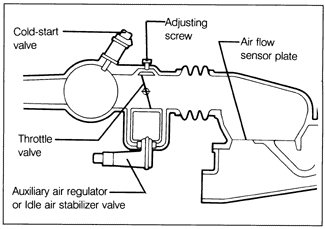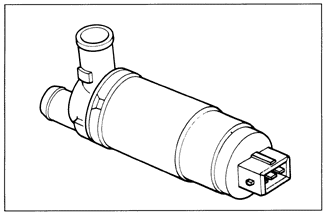6.3 Idle SpeedEngine idle speed is determined by the amount of air entering the engine intake with the throttle closed. On cars covered by this manual, idle speed-the amount of air entering the engine intake-is controlled not by the position of the throttle valve, but by an idle air bypass, allowing a small amount of air to bypass the throttle. An adjusting screw controls air admitted through the bypass, and idle speed is independent of the closed position of the throttle. Idle speed, therefore, is not affected by stretch in the accelerator cable or wear in the throttle valve mechanism. The idle air bypass is shown schematically in Fig. 6-27.

The need for additional inlet air to boost idle speed for cold running is handled much the same way, by allowing additional air to bypass the closed throttle valve. Different CIS-E engines do this in different ways. Basic CIS-E (engine code GX) uses the same system of auxiliary air regulator and idle speed boost valves found on CIS engines. For repair information on these components, see 5.4 Idle Speed. See Adjusting Idle Air Bypass below for information on adjusting idle speed on these engines. The other CIS-E and CIS-E Motronic engines (engine codes HT, RD, PL and 9A) use an electronically controlled idle air stabilizer valve to maintain idle speed within a prescribed range. Fig. 6-28 shows a typical idle air stabilizer valve. This is a closed-loop system in which the control unit continuously adjusts idle speed based on input from sensors. Idle speed under all conditions is electronically controlled and non-adjustable. See Idle Air Stabilizer Valve below for information on idle speed checks and idle stabilizer adjustments for these engines.

|